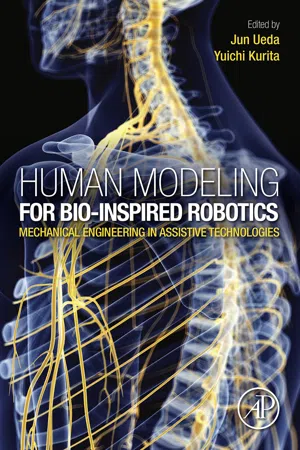
Human Modeling for Bio-Inspired Robotics
Mechanical Engineering in Assistive Technologies
- 358 pages
- English
- ePUB (mobile friendly)
- Available on iOS & Android
Human Modeling for Bio-Inspired Robotics
Mechanical Engineering in Assistive Technologies
About This Book
Human Modelling for Bio-inspired Robotics: Mechanical Engineering in Assistive Technologies presents the most cutting-edge research outcomes in the area of mechanical and control aspects of human functions for macro-scale (human size) applications. Intended to provide researchers both in academia and industry with key content on which to base their developments, this book is organized and written by senior experts in their fields.
Human Modeling for Bio-Inspired Robotics: Mechanical Engineering in Assistive Technologies offers a system-level investigation into human mechanisms that inspire the development of assistive technologies and humanoid robotics, including topics in modelling of anatomical, musculoskeletal, neural and cognitive systems, as well as motor skills, adaptation and integration. Each chapter is written by a subject expert and discusses its background, research challenges, key outcomes, application, and future trends.
This book will be especially useful for academic and industry researchers in this exciting field, as well as graduate-level students to bring them up to speed with the latest technology in mechanical design and control aspects of the area. Previous knowledge of the fundamentals of kinematics, dynamics, control, and signal processing is assumed.
- Presents the most recent research outcomes in the area of mechanical and control aspects of human functions for macro-scale (human size) applications
- Covers background information and fundamental concepts of human modelling
- Includes modelling of anatomical, musculoskeletal, neural and cognitive systems, as well as motor skills, adaptation, integration, and safety issues
- Assumes previous knowledge of the fundamentals of kinematics, dynamics, control, and signal processing
Frequently asked questions
Information
Implementation of Human-Like Joint Stiffness in Robotics Hands for Improved Manipulation
Abstract
Keywords
1 Introduction
Table of contents
- Cover image
- Title page
- Table of Contents
- Copyright
- Contributors
- Motivation
- About This Book
- Part I: Modeling of Human Musculoskeletal System/Computational Analysis of Human Movements and Their Applications
- Part II: Modeling of Human Cognitive/Muscular Skills and Their Applications
- Index